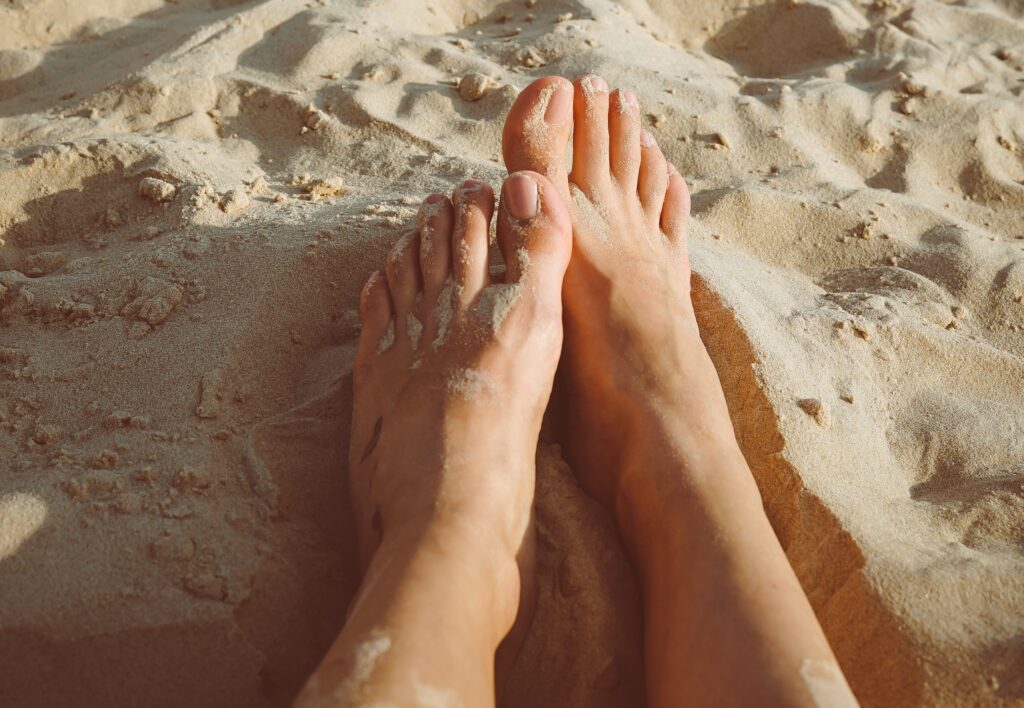
Toe Spacers for Foot Injuries
No matter your lifestyle or level of physical activity, foot & ankle issues are quite common. Many who have foot injuries might wear specific shoes, custom orthotics, opt for expensive and painful surgeries (which aren’t ideal), or just limit their physical activities. I want to share my first-hand experience with the use of toe spacers – specifically for neuroma but this discussion may also help anyone with metatarsalgia or plantar fasciitis. Feel free to share your experience, questions, or comments!
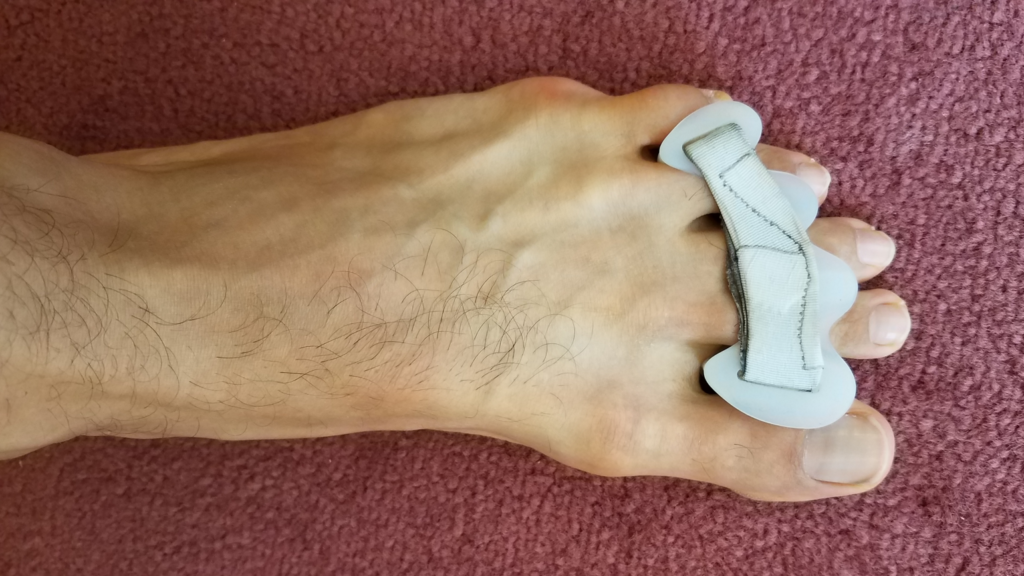
Background
I’ve been using toe spacers for a few years. I first started upon symptoms of a pinched nerve in my foot resulting from:
- Improper footwear which consisted of shoes that squeeze the toes, and had a slight lift of the toes (aka, toe spring) which rolls you nicely into the next step while walking, but not great for the feet
- Wearing shoes for nearly the entire day especially for work
- Excessive time sitting at work and on the computer
- Imbalance/tightness in the hips
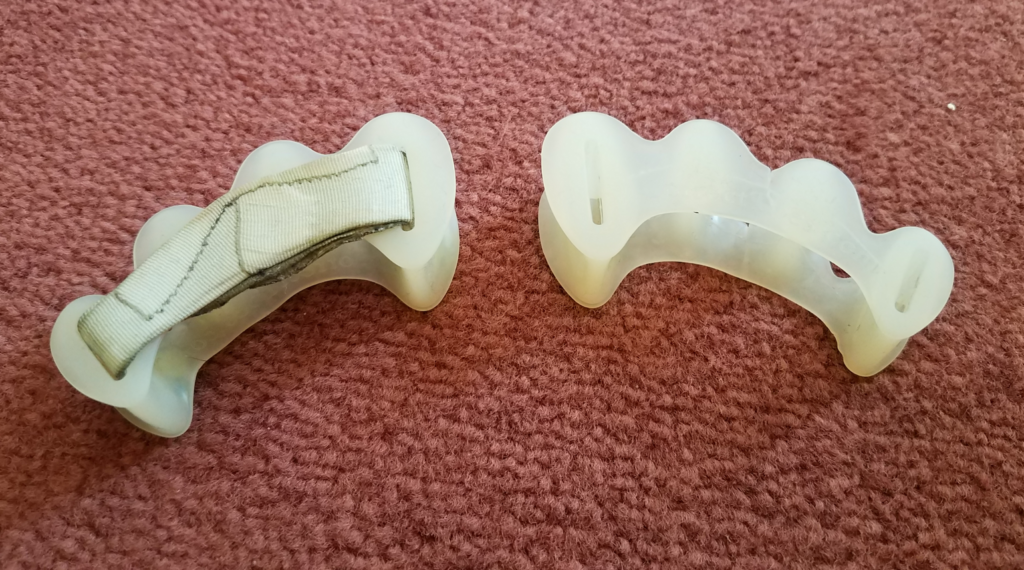
Left Toe spacer has a shim going thru the outer slots, cut from aluminum sheet metal (covered in athletic tape).
The use of toe spacers began as an experiment to see if I might get any relief from the inflammation around the pinched nerve, and I progressed thru different types of toe spacers which I outline below.
First are some of the benefits I aimed for, and results:
1) Relief from Neuroma and Inflammation in the Forefoot – Yes
For my situation, they definitely provided relief for me, the spread of the toes provided enough separation between the metatarsals around the nerve that was injured to lessen pain.
2) Straighten Toes – Yes
Particularly hammer toe of the small toe that was turned nearly sideways due to shoes with narrow toe box, over time I did notice a correction with that and have seen people with crooked toes or other conditions that may experience some benefits with toe straightening as well.
3) Strengthen Feet, Arches – Yes
I think the primary thing that led to strengthening my feet was the shift to minimalist shoes with wide toe box, and lot more barefoot walking, either on grass or around the house, even at the gym in toe socks (often with toe spacers).
But I think the combination of the minimalist shoes and barefoot walking was aided by toe spacers. Spreading the toes helps maintain natural shape of the foot and thus strengthen the muscles of the feet. I found that putting my toes in a more natural spread (when my foot had been almost molded to the shape of most of the narrow footwear I had previously used) felt like it strengthened the foot even more than without.
I noticed the bottoms of my feet strengthening (relative to the tightness I typically felt in the top of my foot) and I noticed the arches of my feet getting stronger (and higher), starting with the medial arch and even feel some strengthening in the lateral arch. Now when I walk, do yoga, or do calisthenic movements, I have much more proprioceptive awareness of the muscles of the feet that are activating.
For these reasons I think toe spacers may be of help with people with plantar fasciitis – though likely with other corrective exercises that improve hip and ankle mobility resulting in less strain on the foot.
4) Correcting Bunion – this I can’t vouch for, at least not yet
After finding relief from the pinched nerve and moving towards improving foot function, a goal of mine was to restore my foot to its natural shape. But this I’ve found to not be so easy. Attempts at this include wearing toe spacers that push the toes beyond natural toe splay, wearing toe spacers at night, and wearing toe spacers in addition to the use of athletic tape over the bunion (specifically the one on the small toe, not large toe).
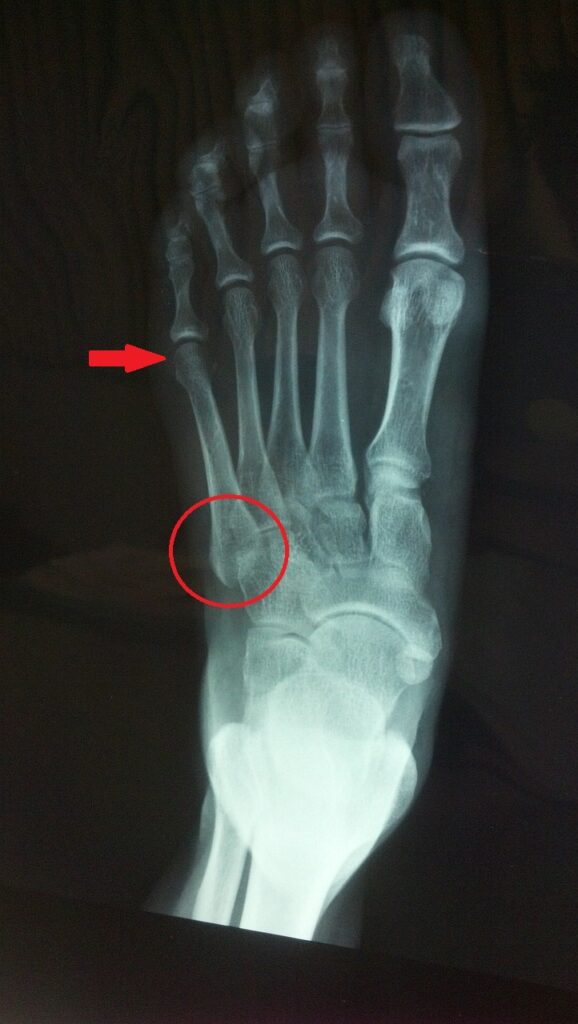
While I don’t think I’ve drastically changed the angle of the metatarsal at the 5th toe where the bunion is, I have found that I am able to ‘adjust’ where the 5th metatarsal meets the mid-foot, cracking that joint by placing outward pressure on the insides of the 5th and 4th toes with my index & middle fingers combined with inward pressure on the bunion from my thumb (see arrow in image) – and in this position, it’s the flexing of the lateral arch that causes a crack at that joint circled (sometimes) which actually provides some relief. But this is only possible after forcing my toes apart with wide toe spacers for 20+ minutes (image of x-ray is a stock image, not my actual foot).
I haven’t found a chiropractor with experience adjusting the bones of the foot, but this experience makes me think it is possible, just as a chiropractor adjusts the spine, just may not be so simple. I would love to hear your views on whether you’ve found adjustments to the foot as possible!
While I haven’t fully reversed the bunion I have, I do find that toe spacers make certain side to side movements or explosive movements during exercise much more comfortable, which give me belief that they may help others with metatarsalgia as well.
How Foot Issues Develop: Bottom Up and Top Down
Foot issues can start within the foot (i.e., bottom up) and thus cause problems at the knee and hip. An example here could be improper fitting shoes, tight shoes, high heels, acute injuries, etc.
But foot issues can also be the result of hip, knee and ankle issues (i.e., top down). If the hips are excessively tight this can have effects down to the knee, and impact movement at the foot. Common here is anterior pelvic tilt where the pelvis is tipped forward and lacks range of motion. This not only stretches the hamstrings, but the lack of mobitlity at the hips can lead to secondary muscles like calves/ankles/feet taking over motion to balance the body during movement that is typically done at the hips. It’s not uncommon for someone with issues at the hip to develop issues at the knee. Ankle strains or sprains can happen with or without hip issues, and these can also impact the feet.
Limitations
I’m not a doctor, everything here is my first hand experience from experimentation with toe spacers of different sizes and types so remember to talk to your podiatrist before trying anything new. I started with individual toe spacers, then increased in size, I eventually progressed to a single unit, and then modified that single unit into a ‘semi rigid’ orthotic by cutting a single piece of aluminum that would act as a shim by fitting between slots between the silicone at the 5th + 4th toes, and the 2nd + 1st toes (see image above).
This gets to an issue that many people I’ve met who have tried toe spacers mention to me – that they tried them but they are uncomfortable. I do agree with this but also believe there are workarounds – if I tried spreading my toes too much too soon, without progressing up to certain width, then yes that was uncomfortable. Or what’s typical if I’m wearing shoes for an 4+ hours, I’ve found a compression of inward force from the toe spacers that meets at the 3rd toe, and a constant rubbing that can occur, which can be uncomfortable. Having socks that are too tight are uncomfortable (with or without toe spacers). For me, this is almost entirely resolved with the use of the ‘semi rigid’ toe spacers (see image above) – the semi rigid prevents force from compressing at the middle toe. None of this is an ideal solution, but neither is surgery or some of the other alternatives.
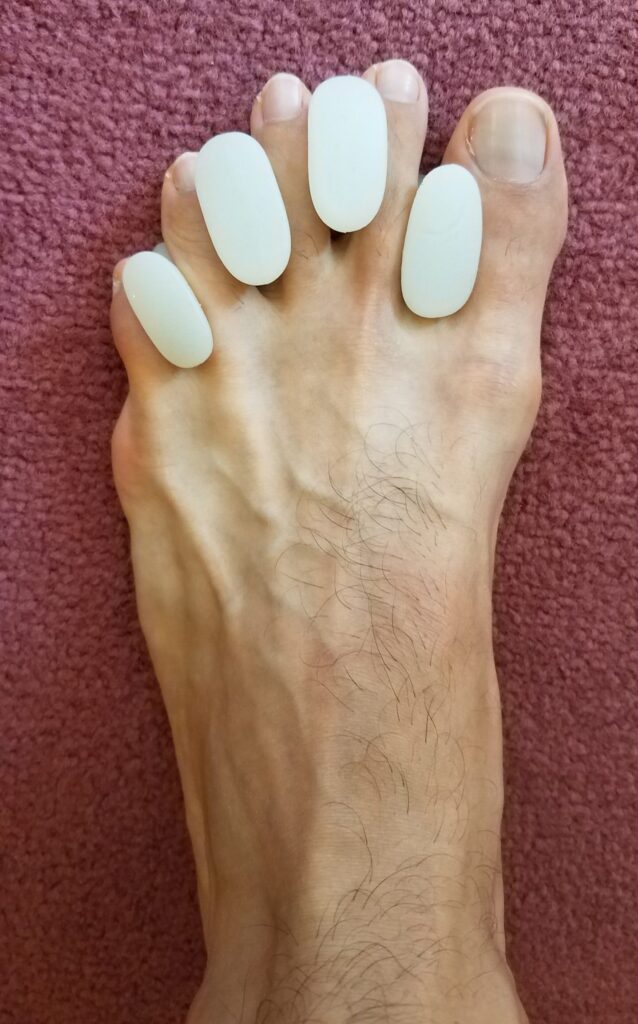
Toe Spacers can cause rubbing due to inward pressure, particularly from shoes & socks.
Recommendations
Talk to your podiatrist about anything you plan to do. I would have never tried toe spacers if I wasn’t already in pain. So my recommendation for anyone interested is only try if you really have to because there are other steps you can do to take care of your feet. You can start by first getting rid of shoes with narrow toe box, excess height in the heel (heel-toe drop), and toe spring by transitioning to more minimalist shoes (though this can depend on any physical limitations, injuries, or discomfort). Do more barefoot stuff if possible – on turf, grass, around the house. Work on improving hip and ankle mobility to restore proper foot function – this ensures primary muscles meant for movement and balance, such as those at the hips, are doing their job properly. Doing ankle and foot exercises helps. And strengthening the toes and doing toe exercises helps too.
With toe spacers – talk to your doctor before doing anything. Start small, wearing them with just socks can work, though wearing them with toe socks (without shoes) might require thicker spacers so they don’t fall out so easily. The connected toe spacers are highly recommended with normal socks, and I’ve found a lot of success with the aluminum shim I crafted which prevents inward force on the middle toes – I found aluminum sheet metal has a lot of strength that it hasn’t broken, it has a little bend to it and sometimes I need to bend it back into shape – so this part you would just need to be careful with. The progression I made was the small individual spacers, to larger individual spacers to the individual connected toe spacer, to the semi rigid toe spacer. I’ve also cut toe spacers, trimming some of the sides, which provide much less discomfort or rubbing between the 2nd-4th toes.
Be very careful of shoes that are not wide enough – I’ve even had trouble with some minimalist shoes that were harder rubber because it created a lot of pressure between the toes or jammed my small toe into the edge of the shoe – but some of the issue I’ve had is also related to improper foot mechanics and very tight calves and some lingering hip imbalance that causes me to roll/twist thru gait in a manner that causes excess rubbing at the outer edge of the big toe and outer bunion of the small toe – so I’m still working to correct that.
Injuries happen in life. And foot injuries are quite common especially as people develop certain patterns in the way they move (or sit) all day. But fixing foot issues, and strengthening feet is possible.
Let me know your questions, comments, or reactions!